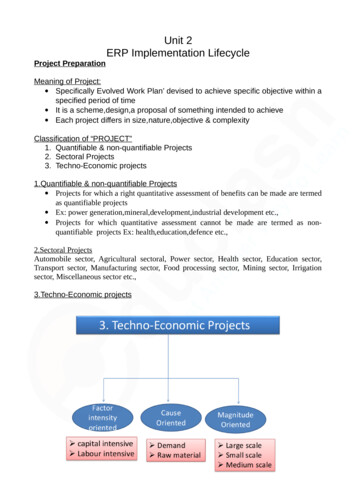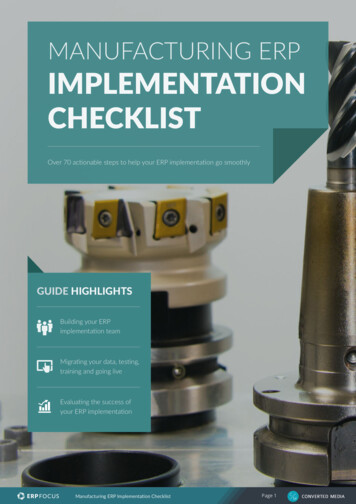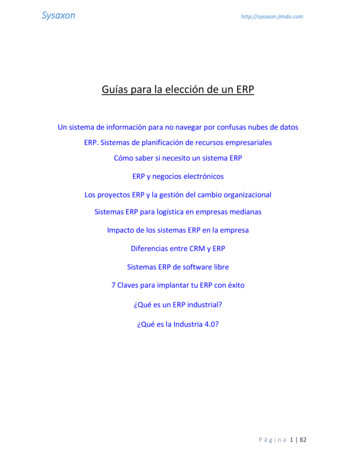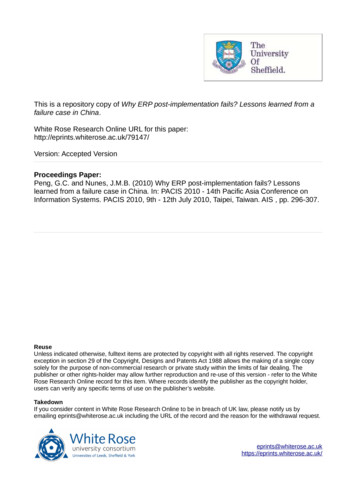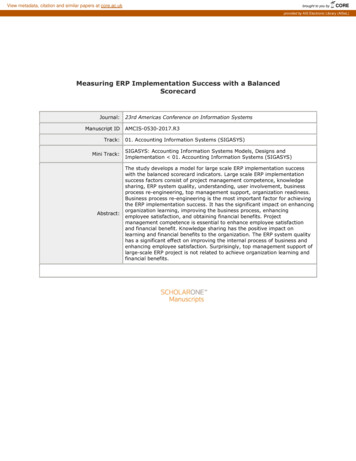
Transcription
View metadata, citation and similar papers at core.ac.ukAmericas Conference on Information Systemsbrought to you byMeasuring ERP Implementation Success with a BalancedScorecardJournal:Manuscript IDTrack:Mini Track:Abstract:COREprovided by AIS Electronic Library (AISeL)23rd Americas Conference on Information SystemsAMCIS-0530-2017.R301. Accounting Information Systems (SIGASYS)SIGASYS: Accounting Information Systems Models, Designs andImplementation 01. Accounting Information Systems (SIGASYS)The study develops a model for large scale ERP implementation successwith the balanced scorecard indicators. Large scale ERP implementationsuccess factors consist of project management competence, knowledgesharing, ERP system quality, understanding, user involvement, businessprocess re-engineering, top management support, organization readiness.Business process re-engineering is the most important factor for achievingthe ERP implementation success. It has the significant impact on enhancingorganization learning, improving the business process, enhancingemployee satisfaction, and obtaining financial benefits. Projectmanagement competence is essential to enhance employee satisfactionand financial benefit. Knowledge sharing has the positive impact onlearning and financial benefits to the organization. The ERP system qualityhas a significant effect on improving the internal process of business andenhancing employee satisfaction. Surprisingly, top management support oflarge-scale ERP project is not related to achieve organization learning andfinancial benefits.
Page 1 of 10Americas Conference on Information SystemsMeasuring ERP Implementation SuccessMeasuring ERP Implementation Successwith a Balanced ScorecardFull PaperSiriluck RotchanakitumnuaiThammasat Business SchoolThammasat University, Thailandsiriluck@tbs.tu.ac.thAbstractThe study develops a model for large scale ERP implementation success with the balanced scorecardindicators .Large scale ERP implementation success factors consist of project management competence,knowledge sharing, ERP system quality, understanding, user involvement, business process reengineering, top management support, organization readiness .Business process re-engineering is themost important factor for achieving the ERP implementation success .It has the significant impact onenhancing organization learning, improving the business process, enhancing employee satisfaction, andobtaining financial benefits .Project management competence is essential to enhance employeesatisfaction and financial benefit .Knowledge sharing has the positive impact on learning and financialbenefits to the organization .The ERP system quality has a significant effect on improving the internalprocess of business and enhancing employee satisfaction .Surprisingly, top management support of largescale ERP project is not related to achieve organization learning and financial benefits.KeywordsBalanced scorecard, implementation success, large-scale ERP.IntroductionMany organizations expect to use enterprise resource planning system (ERP) to support business processgrowth and provide strategic information to their managers. The ERP systems encompass softwareproducts that support accounting and other functional operations and improve management decisionmaking ability (Costa et al. 2016). Large-scale ERP (e.g. Oracle, SAP) implementation requires more budget,human resources, and time. High investment in large-scale ERP system does not always guarantee benefitsto the firm (Ram and Corkindale, 2014; Vidyaranya and Cydnee, 2005), especially in Thai culture andmanagement style (Prachit and Chookhiatti, 2005).To fulfill long-term performance of the organization, large-scale ERP implementation success requiresboth financial and non-financial measures (e.g. employee satisfaction, process improvement, learning andinnovation). The balanced scorecard (BSC) provides a comprehensive measurement framework whichconsists of four perspectives: financial, internal processes, customer, and innovation and learning (Kaplanand Norton 1992; Kaplan and Norton 1993; Martinsons et al. 1999). The balanced scorecard is worthwhileto adapt to examine the ERP implementation success factors in Thai context as the balanced scorecardhas the major objective to transform organizational mission into strategies, objectives and measurements.Previous studies of ERP implementation have paid little attention to develop the framework to measurebusiness value of ERP implementation. Rosemann and Wiese (1999) evaluated only project managementeffectiveness of ERP implementation with the balanced scorecard. Huang et al. (2006) used the balancedscorecard to evaluate performance of information security management.Specifically, a careful review finds that no studies have included an assessment of ERP implementationsuccess or large-scale information technology investment and implementation with the integratedTwenty-third Americas Conference on Information Systems, Boston, 20171
Americas Conference on Information SystemsPage 2 of 10Measuring ERP Implementation Successframework of the balanced scorecard. As a result, the objective of this research is to assess the relationshipof large-scale ERP implementation success factors with the balanced scorecard indicators. The results canenhance the understanding and implication of large-scale ERP implementation success factors which canreally improve the whole organization performance and business value in the Thai management context.Literature ReviewBalanced ScorecardKaplan and Norton (2001) suggested that financial measures should be complemented by addingmeasurements that reflect customer satisfaction, internal process improvement, and learning. Martinsonset al. (1999) applied the BSC to evaluate information technology investments in an organization. Huang andLee (2006) used BSC to evaluate the performance of information security projects.In the case of information systems, Martinsons et al. (1999) has contributed a more in-depth theoreticalview of applying BSC in the information system scorecard (IS scorecard). For instance, the IS scorecardreplaced the customer satisfaction view with the end-user within the organization. Moreover, the ISscorecard measures business value instead of financial perspective. The reason is that information systemis a service providing in the organization users, not explicitly a revenue generator unit. In addition, Hansand Tibbits (2000) used the BSC framework to determine strategic management of electronic commerce.In addition, ERP is normally developed for use within the organization, the appropriate measure ofcustomer satisfaction should use the internal customers such as ERP users’ satisfaction instead of externalcustomers satisfaction. The success of ERP implementation depends greatly on perception of ERP userswithin organization. Moreover, internal customer satisfaction should be measured from a variety ofemployees who have been involved and used the ERP system. Due to the nature of the study, internalcustomers in this research consist of multiple levels of informants ranging from operational to themanagement level who have ever been involved the implementation of large-scale ERP. The rationale forthe multiple level informants is to understand the critical issues for the entire processes of ERPimplementation. Hence, the customer perspective in this study is based on the perceptions from internalemployees from both operational and management levels.ERP Implementation SuccessTop management support: One of the ERP implementation success factors is top managementsupport (Costa et al. 2016). Top management should allocate sufficient valuable resources to support andmake the objectives of ERP implementation achieved. A steering committee of ERP implementationshould be set up to communicate the scope and objectives of the project, to engage the ERP project team,and to monitor the ERP implementation progression.Project management competence: Project management ability of the organization plays an importantrole in ERP implementation success. Effective project management includes an implementation plan thatdefines project activities, personnel and a committed project team to support implementation activities.Competent ERP service provider or ERP consultant capability is important to alleviate the problemsduring implementation process and can enhance the implementation success (Markus et al. 2000).Knowledgeable consultant fluently in business functions, ERP project competency is the major keysuccess of ERP implementation (Tarhini et al. 2015).Business process re-engineering: Prior studies indicate that business process redesign is one of themost important factors for ERP implementation success (Ruivo et al. 2014). Many organizations changebusiness process to match or fit with the ERP software to avoid modifying the ERP software and to reducethe gap between current business process and ERP software.Twenty-third Americas Conference on Information Systems, Boston, 20172
Page 3 of 10Americas Conference on Information SystemsMeasuring ERP Implementation SuccessUser involvement: Users involvement in identifying ERP system requirement can create commitmentof employees toward the new ERP system implementation (Wu and Wang, 2006). User involvement isimportant and can enhance the perceived benefit through participating in the ERP implementationprocess, which decreases users’ resistance of the new developed ERP systems (Wang and Chen, 2006).Knowledge sharing: Knowledge sharing among the key players of ERP project management is one ofthe importance success factors (e.g. ERP vendor, consultants, IT specialists, and business users)(Ampairatana and Rotchanakitumnuai, 2008; Shao et al. 2012). Knowledge sharing can be explicitknowledge or tacit knowledge among management / operational staff, vendors, and consultants during theimplementation process (Nonaka and Takeuchi, 2005).Organization Readiness: Organizational readiness of information technology usage intensity andknowledge of personnel are major success factors of new information system implementation (Chircu andKauffman, 2000). The usage intensity of information technology of firms assists organizations to adoptnew technology more than less experienced ones. In addition, new system implementation requirescomplex understanding, knowledge, and experience to utilize ERP capability. Firms need to recognize theimpact of selecting the right employees or managers with the right skill set, e.g. having knowledge of thebusiness functions, having experience in information systems, having interpersonal skills, and being ableto work with people (Shao et al. 2012; Zhang et al. 2005). Lack of organization readiness is the mostimportant factor that leads to large-scale ERP implementation failure.ERP system qualityThe ERP system should fit the firm’s requirements and achieve the project objectives. The inappropriateERP systems with errors can increase implementation time and cost overruns. ERP system with accuracy,ease of use, and timeliness output indicate the ERP system quality that can enhance organization endusers satisfaction (Kanellou and Spathis, 2013).Communication with UnderstandingA clear understanding of the objectives and importance ERP implementation has to be communicatedthroughout the organization, especially to users who will use the ERP system. Communication helpsemployees recognize how ERP affects current operations. Organization communication comprises theformal announcement of top management and ERP project manager. ERP implementation progress needsto advertise to all levels and functions of the organization (Shao et al. 2012).Effective implementation of ERP systems requires extensive adaptation of the employee’s currentbusiness processes to be able to fully utilize the capability of the new systems. New skills and newprocesses needed when organizations redesign things to use ERP systems require employees to learn newthings. New technology sometimes requires complex understanding and mental capabilities that may bedifficult to manipulate due to the limited capability of human employees (Chircu and Kauffman, 2000).ERP users need to be trained to improve knowledge of the ERP system specification and understand howto use the ERP system efficiently (Costa et al. 2016). Specific to ERP project implementation, one majorproblem of ERP implementation is losing experienced personnel after the project was complete. Hence,the organization can provide education and training to create expertise and knowledge of the personnelwithin the organization in several aspects; such as understanding the features, and training how toimplement the systems.Research FrameworkPrevious studies have proposed various frameworks to identify the outcome of ERP implementationsuccess. Information system performance assessment has become essential as it can identify worthwhile ofthe investment. For instance, Zhang et al. (2005) determined the individual task performance improvementTwenty-third Americas Conference on Information Systems, Boston, 20173
Americas Conference on Information SystemsPage 4 of 10Measuring ERP Implementation Successor user satisfaction from ERP adoption. In addition, DeLone and McLean (2003) measured the ISperformance with organization performance level, operating cost, overall productivity improvement, andcustomer service level. Markus and Tanis (2000) measured ERP implementation success with projectmetric, operational metric and long-term business result. Ruivo et al. (2014) measured the ERPimplementation success with project perspectives (e.g. cost, time, performance, and benefit). However, inthe current competitive business environment, the ERP success evaluation should seek to use theimprovement and effective measurement as the balanced scorecard, which supports the measurementfrom various perspectives; financial, customer, internal process, and organization learning. Moreover, theadvantage of measuring success with the BSC is that many organizations adopt the BSC to implementbusiness strategy, which information technology investment needs to support and align with businessstrategy.Prior work revealed that ERP project team competence, ERP system product quality, vendor knowledgesharing, user involvement, degree of training and communication business process re-engineering, andorganization readiness can enhance ERP system success (Wu and Wang, 2006, Bradford and Gerard,2015). To date, the literatures have been painted a fragmented view about the impacts of ERPimplementation success factors on the four key measurements of the BSC. The qualitative pilot researchindicates that ERP success factors have the positive impact on each measurement of the BSC, which havesimilar relationship with the study of Zhang et al. (2005).The success of ERP implementation can create organization learning and innovation (Nwankpa andRoumani, 2014). The first hypothesis is:H1: The higher level of ERP implementation success factors, the higher level of organizationlearning and innovation.ERP implementation success factors can enhance internal process improvement. For instance, businessprocess re-engineering during ERP implementation can enhance internal process improvement(Bradford and Gerard, 2015). The second hypothesis is:H2: The higher level of ERP implementation success factors, the higher level of internal processimprovement.Success factors of ERP implementation enhance employee satisfaction. For instance, Kanellou and Spathis(2013) determined user satisfaction from ERP adoption. The third hypothesis is:H3: The higher level of ERP implementation success, the higher level of employee satisfaction.Ruivo et al. (2014) revealed that the ERP implementation success can decrease operational cost andincrease organizational benefit. The fourth hypothesis is:H4: The higher level of ERP implementation success factors, the higher level of financial benefitsto the organization.MethodologySurvey research was applied to collect data from large private and public companies that have alreadyimplemented large scale ERP (e.g. SAP, ORACLE). The questionnaire content was divided into threesections. In section one, the questions about ERP implementation success factors are measured by aLikert’s scale ranging from 1 strongly unimportant to 6 strongly important. Section two consists ofquestions to measure the balanced scorecard of the ERP implementation results by a Likert’s scaleranging from 1 strongly disagree to 6 strongly agree. The sample selection method is judgmentsampling, with respondents chosen from large private and public companies. Data collection proceeded bycalling the targeted manager from each firm in order to inform them about the study and to encourageTwenty-third Americas Conference on Information Systems, Boston, 20174
Page 5 of 10Americas Conference on Information SystemsMeasuring ERP Implementation Successthem to respond. 290 questionnaires were sent out. Consequently, a total 275 questionnaires werecollected with 94% response rate. Table 1 indicates the characteristic of respondents. The average ERPusage duration of ERP products (e.g. Oracle, SAP, As400 etc.) is about 5.96 years.CharacteristicsOrganization typePrivatePublicGovernmentWork sAdministrationITHuman resourcesOthers (e.g. logistic, purchasing)PositionTop managementMiddle managementPrimary management LevelOperation levelERP productOracleSAPAS400DANAOSPeople SoftOthersAverage ERP usage duration 5.96 2136231.653.00.74.81.40.8Table 1. Respondent ProfileAnalysisExploratory factor analysis was conducted in order to examine the ERP implementation success factors.The result showed eight success factors: project management competence, ERP knowledge sharing, ERPsystem quality, communication with understanding, user involvement, business process re-engineer, topmanagement support, and organization readiness of adopting ERP (Table 2). Table 3 shows the fourconstructs of the balanced scorecard indicators. The measurement items of each construct showedreliability with high value of Cronbach’s Alpha coefficients (Table 2 and Table 3).Factor score was used to assess the relationship of ERP implementation success factors and the fourbalanced scorecard indicators. The regression analysis result showed that business process re-engineeringand knowledge sharing factors have the positive impact on learning whereas top management support hasa negative impact on enhancing organization learning and innovation. Top management support of ERPproject is not strong enough to achieve organization learning, especially in the ERP implementationprocess. Findings show that a higher level of positive management support needs to be employed (Table 4).Twenty-third Americas Conference on Information Systems, Boston, 20175
Americas Conference on Information SystemsPage 6 of 10Measuring ERP Implementation ject management competence (Cronbach’s Alpha .816)-ERP implementation project leader competence-ERP implementation team competence-A clear ERP implementation project management Plan-Problems anticipation continuously-Careful selection of vendor and software package for ERP implementation-ERP software consultants have successfully experiences in ERP ImplementationKnowledge sharing (Cronbach’s Alpha .852)-Knowledge transfer from ERP consultant experiences to the ERP user-Knowledge transfer from consultantto project team members by ERP implementation manual-Knowledge transfer from consultant’sERP implementation experiences to the project management team- Knowledge transfer from project management team to user byERPimplementation manualERP system quality (Cronbach’s Alpha .861)-ERP system is able to serve user needs-ERP system is able to create report as expected-ERP system is easy to use-ERP system is generated accuracy dataCommunication with Understanding (Cronbach’s Alpha .784)-Communication to Stakeholders to make an understanding of the ERP benefits-Communication to stakeholders to aware of the organizational change-Communication to Stakeholders to create a positive attitude for the use of ERP-Training ERP users to have ability to useUser involvement (Cronbach’s Alpha .816)-User involvement in defining ERP process-User involvement in indicate reports requirement-User involvement in defining organization’s ERP system needsBusiness process re-engineer (Cronbach’s Alpha .810)-Reduce process to make organization work faster-Improvement of customer service process-Reduce process to acceleration of reports generatingTop management support (Cronbach’s Alpha .750)-Top management support throughout the ERP implementation-Change management support by top management-A clear policy specific to ERP implementationOrganization readiness (Cronbach’s Alpha .777)-Evaluation of IT infrastructure readiness for ERP Implementation-Evaluation of employee capability for the use of ERP-Evaluation of IT personnel capability for solving anticipation in ERP adoptionTable 2. ERP implementation success factorsTwenty-third Americas Conference on Information Systems, Boston, 20176
Page 7 of 10Americas Conference on Information SystemsMeasuring ERP Implementation SuccessFactorLoadingFactor/ItemOrganization learning and innovation (Cronbach’s Alpha .862)- help employee initiate new idea for process improvement by using IT- create new working relationships and information sharing among employee for theuse of IT effectiveness- encourage employee to continue learning new thingsInternal process improvement (Cronbach’s Alpha .877)- support management information to help top management in planning anddecision-making- accelerate report generating- reduce work processSatisfaction (Cronbach’s Alpha .860)- create management satisfaction- create employees satisfaction- create users satisfactionFinancial benefit (Cronbach’s Alpha .936)- create sustainable profitability- reduce costs of business- increase organization .822.799.707Table 3. The Balanced Scorecard indicatorsPath to dependent variablePath fromindependent variablesProject management competenceTop Management supportUnderstandingUser involvementBusiness process re-engineerKnowledge sharingERP system qualityOrganization readinessR2**OrganizationLearning 272**-.154-.050.279**.254**.138.001.182Sig p .05Table 4. Impact of ERP implementation success factors on the Balanced Scorecard indicatorsIn the internal process improvement, the results indicate that business process re-engineering and ERPsystem quality factors have significant effects on improving the internal process of business. Businessprocess re-engineering has the higher impact on internal process improvement. The result of process reengineering can help a firm to operate more efficiently. Moreover, good project management, businessprocess re-engineering, and ERP system quality can create satisfaction to management, customer, andinternal employees. Finally, the contribution of good project management, business process reengineering, ERP system quality, and knowledge sharing can provide financial benefit to the organization.There was no significant relationship between organization readiness and the four BSC measurements.User involvement and understanding were also not significantly related to the BSC measurement.Twenty-third Americas Conference on Information Systems, Boston, 20177
Americas Conference on Information SystemsPage 8 of 10Measuring ERP Implementation SuccessConclusion and ImplicationsLarge-scale ERP implementation success is very important as the ERP system consolidates accountingand business information across the organization units and enables organization to increase productivityand make effective decisions. The result indicates that large-scale ERP implementation success consists ofeight factors. Project management competence consists of a clear ERP implementation projectmanagement plan, problems anticipation continuously, ERP implementation project leader competence,ERP implementation team competence, careful selection of vendor and software package for ERPimplementation, and ERP software consultants with successful experience in ERP implementation.Knowledge sharing are measured using two explicit and two implicit knowledge items: knowledge transferfrom the consultant to project team members by using ERP implementation manual, knowledge transferfrom project management team to user by using ERP manual, knowledge transfer from consultant’s ERPimplementation experience to the project management team, and knowledge transfer from consultant’sERP implementation experiences to the ERP user. ERP system quality is determined by ease of use, theability of providing accurate data, serving user needs, and creating required reports. Communication withunderstanding consists of training users to be able to use ERP system more efficiently andcommunication to organization stakeholders, such as communication to stakeholders to create a positiveattitude for the use of ERP, to aware of the organizational change, and benefits of adopting ERP. Threeitems pertaining to user involvement are user involvement in defining organization’s ERP system needs,indicating reports requirement, and defining business process.In addition, business process re-engineering is determined by three items: business process reduction tomake organization work faster, improvement of customer service process, and faster report generation.Management support is identified by top management support throughout the ERP implementation, aclear policy specific to ERP implementation, and change management support by top management.Finally, organization readiness is classified by the evaluation of IT infrastructure readiness for ERPimplementation, IT personnel capability for solving anticipation in ERP adoption, and employeecapability for the use of ERP. The findings from the study suggest several management issues fororganizations that implement large-scale ERP system.Business process re-engineering is an important factor for achieving the ERP implementation successbased on the four BSC indicators. The business process re-engineering factor has a significant impact oncreating organization learning, improving business process, enhancing satisfaction, and generatingorganization long term profit.Re-engineering business processes requires top management support so that the ERP project team canrestructure the business process to achieve the objectives of the ERP investment. This study showed thatnegative top management support reduced the potential of organization learning dimension of the BSC.This weak point is a concern because of both economic and policy issues. The tangible issue is financialsupport. The budget for ERP implementation sometimes was not sufficient to cover the software cost,implementation costs, and the development costs of add-on solutions.Project management competence is also essential. The Project plan must be well defined and with clearmilestones. Project team member leader needs high experience and active human resources. Projectmanagement should consider selecting the appropriate ERP vendor and consultants so that the ERPimplementation can be developed within the schedule and budget. Good project management candetermine success based financial benefits and client satisfaction.In practice, ERP project implementation limits the customization of software, the ERP systemdevelopment process was sometimes done concurrently with the business process improvement. Hence,the ERP system must be implemented according to the users’ needs. The outcome of ERP system mustTwenty-third Americas Conference on Information Systems, Boston, 20178
Page 9 of 10Americas Conference on Information SystemsMeasuring ERP Implementation Successhave suitable modules of business functions, provide accurate and timely information and reports to usersat all levels.Finally, this study integrates prior research on ERP implementation success including an additional factorknowledge sharing. Knowledge sharing has a major impact on enhancing organization learning. Pastresearch observed the effects of knowledge enterprise factors on system implementation (e.g. Shao et al.2012). Sharing knowledge to relevant users can assist the organization to reduce cost and generate profitsin the long run. Implicit knowledge sharing of ERP implementation project needs to be transmitted in theorganization. The transfer of knowledge supports organization to become a learning organization.Although this study was conducted in a context where the respondents are from large organizations, theresults provide some valuable suggestions to any firm currently implementing small scale ERP or areconsidering using the large-scale ERP in the future. Future research can extend the study to SMEs andapply cross-industry samples to broaden the coverage of the study. Research framework can be expandedwith constructs driving the ERP implementation success, such as, organization fit and organizationalculture influences.ReferencesAmpairatana, N. and Rotchanakitumnuai
Competent ERP service provider or ERP consultant capability is important to alleviate the problems during implementation process and can enhance the implementation success (Markus et al. 2000). Knowledgeable consultant fluently in business functions, ERP project competency is the major key success of ERP implementation (Tarhini et al. 2015 ).


